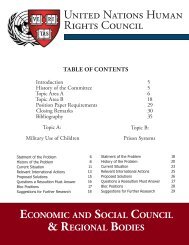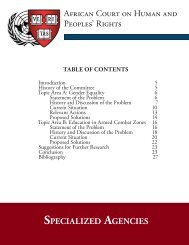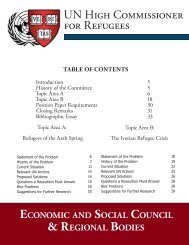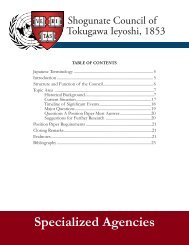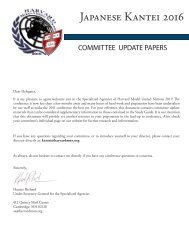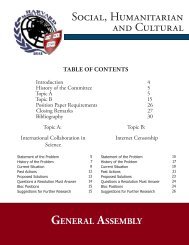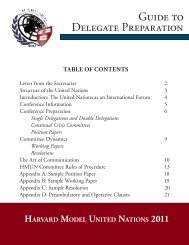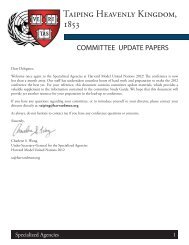World Trade Organization - Harvard Model United Nations
World Trade Organization - Harvard Model United Nations
World Trade Organization - Harvard Model United Nations
You also want an ePaper? Increase the reach of your titles
YUMPU automatically turns print PDFs into web optimized ePapers that Google loves.
<strong>World</strong> <strong>Trade</strong> <strong>Organization</strong><br />
OVOP has had notable success in Malawi. Agriculture<br />
accounts for 90% of Malawi’s exports but Malawi<br />
farmers lacked expertise in promoting their goods abroad<br />
and in growing and managing their farms and businesses.<br />
The Ministry of Economy, <strong>Trade</strong> and Industry (METI)<br />
and the Japan External <strong>Trade</strong> <strong>Organization</strong> (JETRO)<br />
have heavily promoted Malawi’s products to Japanese<br />
consumers as well as helped it export its goods to<br />
neighboring countries like Mozambique. The OVOP<br />
is just one policy in the greater battle to help countries<br />
build trade capacity through the development of human<br />
capital and institutions. 24<br />
Challenges Ahead<br />
Focusing on Competitiveness<br />
Countries need to go beyond purely funding<br />
for economic growth and focus on how to increase<br />
competitiveness in country growth strategies. Governments<br />
have only recently begun using policies to address supplyside<br />
constraints on trade whereas previously, much more<br />
attention was focused on government subsidies to local<br />
businesses to incentivize more production of goods that<br />
result in a slightly higher GDP growth but does nothing<br />
for the overall, sustainable competitiveness of the country<br />
in the global trading system.<br />
First, more focus must be on dealing with the<br />
incentives to trade. Low-income countries need to<br />
implement more operational strategies that deal not<br />
only with lower border barriers like tariffs but also<br />
the tax system, investment policies, and labor market<br />
regulations. By having these favorable policies in those<br />
areas, production of more goods will lead to more profit<br />
that can be better spent on investments in human and<br />
capital. Furthermore, governments must focus on<br />
how to build the service infrastructure (transportation,<br />
telecommunications, finance) that reduce production<br />
costs for firms and increase their competitiveness. Lastly,<br />
these price incentive policies must be complemented<br />
with proactive policies to promote exports. These policies<br />
include government assistance in obtaining information<br />
about export markets and in ensuring that export goods<br />
are up to the technical and sanitary standards of foreign<br />
countries. 25<br />
<strong>World</strong> Bank and IMF activities<br />
Lending is a crucial tool of the <strong>World</strong> Bank and the<br />
IMF in providing Aid for <strong>Trade</strong> assistance to developing<br />
countries. Concessional and non-concessional lending<br />
that focuses on helping countries bear the cost of making<br />
their economies more export compatible (building<br />
infrastructure etc.) has grown from $400 million in 2000<br />
to more than $1.6 billion 2007. These loans were given to<br />
42 countries located mostly in Europe, Central Asia, and<br />
Africa. Most loans were directed at boosting trade-related<br />
sectors like communications, transportation, regulatory<br />
systems, finance, energy, and rural development. 26<br />
The <strong>World</strong> Bank has also been working closely with<br />
LDCs to implement programs tailored for each country.<br />
Help comes in the form of policy advice for countries<br />
pursuing trade liberalization reforms (such as Ecuador,<br />
Indian, Iraq, Madagascar) and technical assistance for<br />
countries applying for WTO membership (such as Russia,<br />
Ethiopia, and Vietnam). The Bank also gets involved in<br />
A recent Global Development Debate brought experts together to<br />
explore ways to better manage capital flows to and from emerging<br />
economies.<br />
more local aspects of trade capacity building such as<br />
promoting learning events and courses on trade in goods<br />
and services and poverty reduction through trade.<br />
Aside from lending, the IMF mostly focuses on<br />
surveillance of trade policies to ensure that LDCs are<br />
treated fairly in trade negotiations. Furthermore, the<br />
IMF engages in trade-related research to identify traderelated<br />
macroeconomic vulnerabilities in countries and<br />
advises government authorities on how to best address<br />
them. 27<br />
Relevant Action<br />
In addition to the Integrated Framework and the<br />
JITAP mentioned above there are other recent tradeassistance<br />
programs that have already begun to achieve<br />
notable results.<br />
10<br />
Specialized General Assembly Agencies





